192x191/2993 = 12.25.
But maybe you should add MPG, standard engine and light car = 32mpg. so:
12.25 X32 = 392.


You said it was anumbers game!!!

Just out of interest, to satify my curiosity, everybody join in if you have a calculator and we'll rank the results on an engine by engine
basis.
Use rolling road/dyno results or std engine manufacturer data:
Multiply Power (in bhp or PS, they are close enough) by Torque (in lbft NOT Nm) then divide by swept volume in cc
(bhp x lbft)/cc = xyz
I'll kick off with mine:
Vauxhall XE 2.0 16v (204 x 169)/1998 = 17.26
Lets have the results from all engines on here, just as a little game!
Alfa v6=
192x191/2993 = 12.25.
But maybe you should add MPG, standard engine and light car = 32mpg. so:
12.25 X32 = 392.


You said it was anumbers game!!!
Okay to satisfy your curiosity here goes for ZZR 1100
(147 x 76.9) / 1052 = 11.12
Now satisfy my curiosity, what does this formula show?
Cheers Davie
Err...
1.8 CVH
88x108/1769 = bu@@er all.
just a crude measure of the overall "effectiveness" of an engine really, not very scientific, but basically enables a pretty direct
comparison of engines of all sizes and types, without getting into the "bike engine vs car engine" type debate.
You can compare engines in terms of their effectiveness at propelling a car quite well I think, feel free to disagree though! 
But wouldn't you need to divide by £'s spent on tuning? I'm guessing 204bhp isn't a standard XE 
1998 R1
150 * 80 / 998 = 12.0
Your formula misses out revs which is an important part of engine performance. (remember power is proportional to torque times revs)
a 100 BHP turbo diesel will beat a 100 BHP car engine which will beat a 100 BHP bike engine in your formula because your formual is torque x torque x
revs / cc.
What is it you're trying to prove?
I propose a different formula
torque x max revs / cc.
R1 = 80 *12000 / 998 = 961
XE = 169 * 7000 / 1998 = 592
1.8 CVH = 108*6000/1769 = 336
ME disagree!!! I'll certainly think about it
Rover V8 efficient OH well !!
Oh well here goes in Std form
(203x149)/4200 = 7.201 
and I am not starting on the MPG but it still scares grannies 
 .
.
Regards
Agriv8
Would be interesting to see the average of the revs that give max bhp and ft/lb. Not that high or low values are inherently 'good'.
The formula doesn't really say much about how the car will act on the road/track, but so long as the thread doesn't degenerate into a
"my engine has better 'effectiveness' than yours" d*ck size war it should be interesting.
Finally for reference standard mini cooper S (classic)
(76 x 71) / 1275 = 4.23
Ave rev (5900+3000)/2 = 4450
i like games
182x190/2316 = 14.9
BMEP or MEP - is the only way to compare engines efficiency . some results may scare you .
quote:
Originally posted by smart51
1998 R1
150 * 80 / 998 = 12.0
Your formula misses out revs which is an important part of engine performance. (remember power is proportional to torque times revs)
a 100 BHP turbo diesel will beat a 100 BHP car engine which will beat a 100 BHP bike engine in your formula because your formual is torque x torque x revs / cc.
What is it you're trying to prove?
I propose a different formula
torque x max revs / cc.
R1 = 80 *12000 / 998 = 961
XE = 169 * 7000 / 1998 = 592
1.8 CVH = 108*6000/1769 = 336
quote:
Originally posted by Volvorsport
i like games
182x190/2316 = 14.9
BMEP or MEP - is the only way to compare engines efficiency . some results may scare you .

quote:
Originally posted by Agriv8
Rover V8 efficient OH well !!
Oh well here goes in Std form
(203x149)/4200 = 7.201
and I am not starting on the MPG but it still scares grannies.
Regards
Agriv8






BMEP (brake mean effective pressure) is a measure of how much force acts on the piston. Which is very nice. What makes a car go forwards is the
torque that the engine produces, and not at the flywheel but at the road wheels. BMEP, Max Torque, Max Power etc are all some way removed from what
actually matters.
I was just pointing out that your formula is biased for peak torque when I believe that there is more to it than that. Perhaps I suspect that you
have an ulterior motive
heh heh I do have the motive of comparing all engines, and perhaps "quietening" some of the pro-BEC banter, but equally I have no axe to
grind, if I didn't have the vauxhall stuff already I would have used a Busa mylself!
That is also the reason I added the "divide by cc" bit, if I were just trying to poo-poo bike engines I would just have gone for peak torque
alone!
You can gear a car for all the torque at the wheels that you need, you just fit a crawler gearbox from a tractor, so I am afraid that's not the
answer either!!!! LOL
I am just trying to get as close as I can to a BMEP survey but bearing in mind that nobody will know their BMEP!
Should you not factor in weight also?
<opens another can of worms to add to the pile which is ever-growing!>



ok with this in mind
http://www.locostbuilders.co.uk/viewthread.php?tid=52746
578x520/2316 = 129
we have a winnar !!!
VAG 1.8T
(220*230) / 1781 = 28.411
Quote NSDEV .... is down to cylinder head breathing efficiency....
Oh bu**er - rover v8's - breathes as will as an asmatic 65 year old that smokes 60 a day. 
Of course I could just remorgage the house for a set of Wildcat heads. when the lottery numbers drop LS6 with tremac 6 speed MMMMMmmmmm Nice. 
Note to everyone
This is about statistics at the end of the day the ability to reference one engine againt another using a calculation and yes we all understand that
the calculation is not the most accurate but lets keep it POLITE please. ( PS my D*ck is bigger than everyones 
 )
)
Agriv8
quote:
Originally posted by Volvorsport
ok with this in mind
http://www.locostbuilders.co.uk/viewthread.php?tid=52746
578x520/2316 = 129
we have a winnar !!!
bit late here but..
219x169/2092=17.69
I'm loving that Manta, but it sounds all wrong, more like a turbine engine than a 4 stroke.
Cheers
Mike
Now there must be a bike engine that can compare with Chris's S2000 engine (current highest nat asp engine) or ned's XE (second
highest)???
I'm NOT doing this to wind anybody up, just to see how things compare!
What torque does a std hayabusa make? Needs to be around 125 lb ft to pull into the lead, which sounds reasonable to me but I just don't know
what they make!
What about the other "newer" bike engines, thay are smaller but I'm guessing more efficient, and engine size will make no difference so
lets see!
Standard quoted torque figure for a Busa is 98.4lb @ 7k rpm. Max power is 158bhp @ 9750 rpm.
So that makes about 11.42 ish?
[Edited on 3/10/2006 by andyd]
There won't be a bike engine that matchs up to the S2000 engine because your formula is biased towards car engines. There are bike engines that make your car faster than an S2000 engine though
That can only be due to power to weight ratio and "maybe" gearing (but that is a whole new can of worms!!!)
To put an "ish" figure on it though, the bike engine car is going to need to be 140kg lighter. (based on 200hp 560kg CEC, 150hp BEC will
need to be 420kg)
I specifically didn't want to get drawn in to this one though!
Lets keep hearing the data as suggested, rather than just power or torque on their own. The divide by cc should bias back to the bike engines.
Anybody know the BMEP for a Busa?
A stock 'Busa is reckoned to be about 98lb.ft. of torque.
I still can't see what your calculation proves though - as someone has said already you're multiplying two factors of torque and an element
of speed, then dividing by capacity, that's all! It doesn't show efficiency.
A standard red-top VX is what, a real-world 140bhp and 130lb.ft of torque? My standard (barring exhaust and air filter) R1 will be 125 rear-wheel bhp
with 75-ish lb.ft of torque. If I chucked enough money at it I could get 170+ bhp and a chunk more torque, still out of 998cc.
An S2000 is about 240bhp and 160lb.ft of torque, but that'll be at the flywheel. So if you factor that into the equation, an R1 is pretty much
equal. Just a damn sight lighter....
So, in conclusion, a big engine works in a heavy car (i.e. large increase in torque against a small relative increase in weight), and a small (i.e.
bike engine) works in a light car. Not that you'd put an R1 into an S2000.....



<hides behind the sofa>
I think if you want to look at the performance and ability of the engine and car combination you have to include the weight.
I like the idea of including the torque figure as this is a far more honest way of looking at engine power.
Believe it or not some of the torquest engines produced were steam,
Max torque a zero revs /min, dont tell me they weren't powerfull.
If you take BHP x Torque and then divide this by the weight of the car , it would give a better picture of performance. And allow the BEC boys in on
the game
(true weight with driver please)
192x191= 36672. / 860kgs (no i'm not fat, its the car honest)
36672/ 860 = 42.64 horsetorques/ kg.
After all its power to weight ratio that gives race cars the edge.
"lies, damed lies and statistics"


quote:
Originally posted by smart51
There won't be a bike engine that matchs up to the S2000 engine because your formula is biased towards car engines. There are bike engines that make your car faster than an S2000 engine though
quote:
Originally posted by Coose
A stock 'Busa is reckoned to be about 98lb.ft. of torque.
I still can't see what your calculation proves though - as someone has said already you're multiplying two factors of torque and an element of speed, then dividing by capacity, that's all! It doesn't show efficiency.
A standard red-top VX is what, a real-world 140bhp and 130lb.ft of torque? My standard (barring exhaust and air filter) R1 will be 125 rear-wheel bhp with 75-ish lb.ft of torque. If I chucked enough money at it I could get 170+ bhp and a chunk more torque, still out of 998cc.
An S2000 is about 240bhp and 160lb.ft of torque, but that'll be at the flywheel. So if you factor that into the equation, an R1 is pretty much equal. Just a damn sight lighter....
So, in conclusion, a big engine works in a heavy car (i.e. large increase in torque against a small relative increase in weight), and a small (i.e. bike engine) works in a light car. Not that you'd put an R1 into an S2000.....

<hides behind the sofa>
quote:
Originally posted by iank
quote:
Originally posted by smart51
There won't be a bike engine that matchs up to the S2000 engine because your formula is biased towards car engines. There are bike engines that make your car faster than an S2000 engine though
How is it biased? the cc divisor would tend to favour BECs.
Cursory glance around the web finds this sidecar racer
http://www.teamfoundsracing.com/thesidecar.htm
(180 x 95) / 1000 = 17.1
The 180 is at the wheel, so add maybe 18 bhp for 10% transmission losses and you get 18.81 which just about beats the S2000
Speed around a track depends more on driver than engine within limits.



quote:
Originally posted by Johnmor
I think if you want to look at the performance and ability of the engine and car combination you have to include the weight.
I like the idea of including the torque figure as this is a far more honest way of looking at engine power.
Believe it or not some of the torquest engines produced were steam,
Max torque a zero revs /min, dont tell me they weren't powerfull.
If you take BHP x Torque and then divide this by the weight of the car , it would give a better picture of performance. And allow the BEC boys in on the game
(true weight with driver please)
192x191= 36672. / 860kgs (no i'm not fat, its the car honest)
36672/ 860 = 42.64 horsetorques/ kg.
After all its power to weight ratio that gives race cars the edge.
"lies, damed lies and statistics"


My tin top (Honda Civic Vti)
169*128/1797 = 12.0
Bit like a bike engine, a guttless slug unless you scream the knackers of it. Fun to drive though.
My other tin top (MR2 Turbo)
225*224/1998 = 25.2
That's more like it...
Horsetorques
I like it!!


Ahh finally things swing in my favour and I can exit from behind the sofa
So on book data
(203x149)/750kg = 40.32 Hoursetorques
Ps I am gong to fit some tune resistors ( you know the ones of e-bay like ) to my efi and get 50 bhp. not really
Vems Fuel and Spark, flowed heads and act performance intake system should see the VE increaed - looking for 230 bhp
(230x149)/750kg = 45.69 Hoursetorques


Better than my 7.201
Agriv8
[Edited on 3/10/06 by Agriv8]
ok so if we apply
578 x 520/700 = 423 -woooo
keepin it sensible
182x190/700 = 49.4
quote:
Originally posted by Coose
A stock 'Busa is reckoned to be about 98lb.ft. of torque.
A standard red-top VX is what, a real-world 140bhp and 130lb.ft of torque?
Did you know that 98.274 percent of statistics are meaningless?
Seriously though, one of the first things learned in a basic statistics class is that "statistics prove nothing", they simply show
probabilities. Statistics can be manipulated in any number of ways to prove or disprove whatever you wish. They are meaningless.
Nevertheless, here are some more figures for your statistical comparison. In our case, manufacturer’s figures have been quoted for statistical
comparison accuracy. 
178bhp x 99ft-lb / 556kg = 31.69
However, if you then multiply the result by the HFF (Hellfire Fun Factor – determined using real statistics!!) (for a BEC use 2. For a CEC use 1) we
get 63.38 Horsetorques 
Phil
LOL

Will admit the sequential box and revs do add a hell of a lot to the grin factor!!!!
Wouldn't mind a run out in a BEC 7 if anybody is offering in the leics area?
Have been in a BEC but with a 1500 Busa its cheating really, be nice to go in a sensible engined one and see how that compared.
been in my mates busa fury nat and that was good fun. few vids on putfile.com/nedc 
Cheers Ned, will take a peek!
Hasten to add, i am about to commence building a BEC of my own, just to prove I am unbiased!!!!
I am cheating though slightly, alleviating the lack of torque by using a TL1000 vee twin, or more correctly, a PAIR of TL1000 vee twins. having seen
their torque characteristics on the dyno, these have the flattest torque curve you have ever seen, and a pair of them just seem to drive like a huge,
very revvy, diesel engine!!
Interestingly, a pair of these engines make a good comparison for a 2.0 car engine. They should total around 280hp and 190 lb ft of torque, they do
deliver over 75% of their peak torque over a huge rev range though, which is the main reason for using them.
Perfect for starts on grasstrack as long as the gearboxes stay together!!!
My mini manages to get a mere
155 x 98/1338 = 11.35. Not bad for such an old engine. Although it does have an 8,800 rev limit.
And the indy gets
164 x 88/1137 = 10.79
Somewhat suprised to see the A series beat a bike engine!
[Edited on 3/10/06 by DIY Si]
that's a pretty serious mini engine!!!!
Yup!
 All built by my own fair(ish) hand too! It does help that it's a very nearly race engine. Very large valve head, over-bored and
destroked to get 1338cc. A VP3C cam, which is sold as a FAST ROAD!!!!! cam. I was going to get the scatter race version, but daren't go near
it!
All built by my own fair(ish) hand too! It does help that it's a very nearly race engine. Very large valve head, over-bored and
destroked to get 1338cc. A VP3C cam, which is sold as a FAST ROAD!!!!! cam. I was going to get the scatter race version, but daren't go near
it! Oh, and the finale is the 48 IDA sticking through the bonnet! Very, very loud and very fast. It also has straight cut drop gears and the box out
of a Metro Turbo Challenge car!
Oh, and the finale is the 48 IDA sticking through the bonnet! Very, very loud and very fast. It also has straight cut drop gears and the box out
of a Metro Turbo Challenge car!
quote:
Originally posted by DIY Si
Very large valve head, over-bored and destroked to get 1338cc. A VP3C cam, which is sold as a FAST ROAD!!!!! cam. I was going to get the scatter race version, but daren't go near it!Oh, and the finale is the 48 IDA sticking through the bonnet!
I would do, but she's strating to look a little tatty/rusty and is currently under a stack of stuff in the garage.  Used to be my daily driver,
but I ended up going to work at over a ton, and decided it may be best to put her away for a while. I'll get some pics of the eninge bay though.
Back in a few.
Used to be my daily driver,
but I ended up going to work at over a ton, and decided it may be best to put her away for a while. I'll get some pics of the eninge bay though.
Back in a few.
Looks like this from the outside. The bonet vent is just a first version, and is a little agricultural
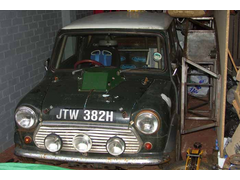

Rescued attachment mini1.jpg
minus bonnet

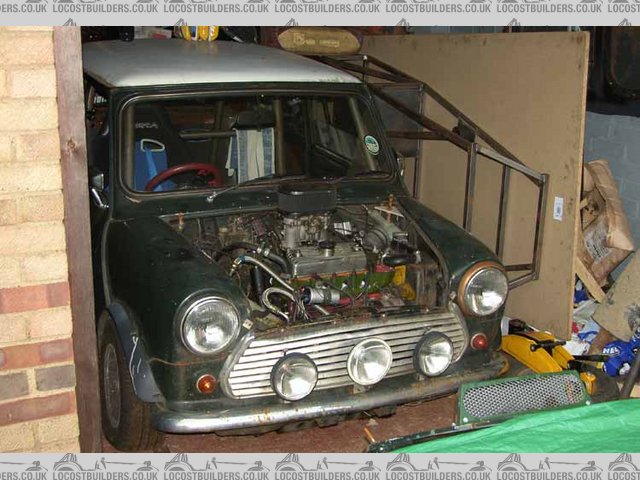
Rescued attachment mini4.jpg
another
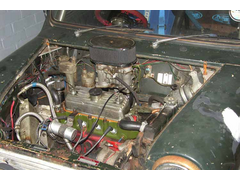

Rescued attachment mini2.jpg
bit closer
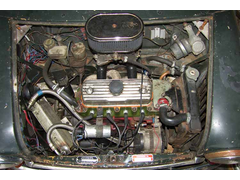

Rescued attachment mini3.jpg
and the head before fitting
yes, there is a gap between the valves, but it's only 40 thou wide! It's a small step down from an out-and-out race head.

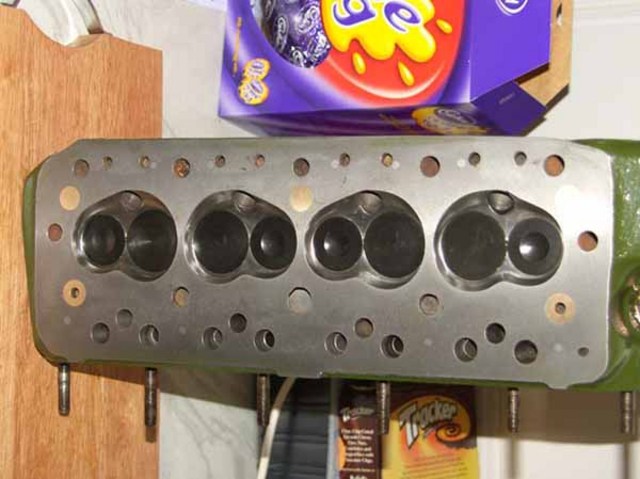
Rescued attachment minihead1.jpg
It drinks that much fuel and air that the inlet manifold turns white on the outside of the bend with ice! And it happens during the summer too. Only
bad points are that you need earplugs to drive for more than 30 mins! And it can be heard from over 3 miles away!
Only
bad points are that you need earplugs to drive for more than 30 mins! And it can be heard from over 3 miles away!



Excellent! I really want to get another mini sometime.
Drove to Silverstone for the 35th Aniversary in my brothers mini with 45DCOE and straight cut drops/box and my ears were ringing for a couple of days
after!
Amazing how many people have come up and told him his gearbox is on it's last legs LOL. It also has a bit of primary gear rattle (286 scatter
cam and ultra-light steel flywheel don't help!) and some old boy knocked on his window and said he should stop the engine ASAP as his cam chain
was going to snap any second 
Mine's a bit like that. The idle varies between 800 and 1500 rpm depending upon it's mood! I've not had anyone say things like that, whihc is a little suprising, but I have had may people stop me and ask what the hell lurks under the bonnet as its one of those enignes that sounds "different", ie highly tuned, rather than boy racered. I know of another local mini that's louder than mine, but is a near standard 998!
heh heh, mini is just one of those cars isn't it, now I want another!
Oh well, will have to settle for the grasstrack one!
Nice car, leave it looking like that, chop the bulkhead and sidedraft it so you can't see the carb and stick it back on the road........go on you
know you want to!!!!


I originally posted this in the wrong thread
The Wartsila-Sulzer RTA96-C turbocharged two-stroke marine diesel engine makes 5,608,312 LB Ft of torque and 108,920 BHP at 102 RPM from 25,480
litres. Its thermal efficiency can excede 50% so fuel consumprion is only 1660 gallons per hour.
5608312*108920/25480 = 23973
http://people.bath.ac.uk/ccsshb/12cyl/
That is a pretty effective engine!!!!!!! 50% thermal efficiency we can only dream of on any of our engines, bike or car!!!!
quote:
Originally posted by smart51
I originally posted this in the wrong thread
The Wartsila-Sulzer RTA96-C turbocharged two-stroke marine diesel engine makes 5,608,312 LB Ft of torque and 108,920 BHP at 102 RPM from 25,480 litres. Its thermal efficiency can excede 50% so fuel consumprion is only 1660 gallons per hour.
5608312*108920/25480 = 23973
http://people.bath.ac.uk/ccsshb/12cyl/


couldn't you pay for the crane with the fuel saving over the v8??









quote:
Originally posted by Agriv8
Id fit one but Id need to buy a sligthly larger engine crane ??
wich you can calculate is how effeccient
or capable is a engine..
this is by talking about BHP / 1000cc
its like BHP / KG or BHP / 1000Kg..
sow a 3,5litlres wich produces 320BHP
will give less results as a 1000xx bike engine with 150BHP and thats just true!
because with 3,5 times the displacement is should generate 3,5times the bhp´s...
Tks
Again not true!
Yes, that will prove how much bhp per litre an engine will generate, but just because my 0.49cc model plane engine generates huge bhp/1000cc
doesn't mean it will be any good at propelling my locost!!!!!!!
As you go through all of these measurements, and in turn rule them out as measures of how they will make a car "go", you will see why I
picked the arbitrary measurement I did!!!
A high specific BHP engine on its own is no good
A high peak torque engine on its own is no good
A high revving engine on its own is no good
A high peak bhp engine on its own is no good
What I hoped to get over with the numbers game, and think I have done, is that it is the whole package that is needed to be "effective" in
powering a car.
In terms of winner for my little numbers game, sticking to naturally aspirated engines fitted to road legal cars, I am pretty sure I know what it is,
but can I find a spec anywhere on tinternet!!!!!...... 
If somebody can find a spec for an Opel-Cosworth 2.5 litre KF V6 then put it up on here (yes I know there is only one road car with one it it but
there you go!!!!).......................
I think you will be looking at over 45 for the (bhp x lbft) / cc equation!!!!!!! 
Was justing looking through a list of power/torques I found at http://www.drivetorque.co.uk/cars/car_specs.htm and I was surprised that big V8's
that you'd expect to be in a relatively soft state of tune provide high numbers to Nats original engine "goodness" formula.
e.g. GM LS1 as found in Vauxhall Monarao, 329bhp, 344 lbft from a 5.7 litre engine gives 19.8.
Best I can find so far is the BMW M3 CSL engine, 360bhp, 274lbft from 3246cc giving a score of 30.4. Not quite "locost" though.
[Edited on 4/10/06 by MikeRJ]
quote:
Originally posted by NS Dev
In terms of winner for my little numbers game... Opel-Cosworth 2.5 litre KF V6 ...
I think you will be looking at over 45 for the (bhp x lbft) / cc equation
Using purely "vague recollection" values for the KF V6, I think peak power was around 415hp and peak torque was around 290lbft, which from
2500cc gives 48!!! Engine also has excellent power density, at around 90kg all up weight!!!
The road legal car it was fitted to was Andy Burton's "306R4" rally car.
The Sulzer diesel, excellent as it is, won't go in a road car!! LOL
[Edited on 4/10/06 by NS Dev]
quote:
Originally posted by NS Dev
Using purely "vague recollection" values for the KF V6, I think peak power was around 415hp and peak torque was around 290lbft, which from 2500cc gives 48!!! Engine also has excellent power density, at around 90kg all up weight!!!
The road legal car it was fitted to was Andy Burton's "306R4" rally car.
The Sulzer diesel, excellent as it is, won't go in a road car!! LOL
[Edited on 4/10/06 by NS Dev]
 thats a shame
thats a shame just thinking my daily driver diesel:
140*259/1896= 19.12
them there turbos blow the plot away again!!!
How about this one, a lombardini 686cc diesel
30 Lb ft, 17 BHP, 686cc = 0.74
pug 106 (TU9 carb)
(45 x 72)/ 954 = 3.4
with the factory data -> add real life and 14 years and it's probibly more like 35x60/954 = 2.2 

quote:
Originally posted by smart51
How about this one, a lombardini 686cc diesel
30 Lb ft, 17 BHP, 686cc = 0.74
Ok then, 'er indoors' Mk1 '66 Mini: -
24(bhp) x 59 (lb.ft) / 998 = 1.42!

piaggio air cooled 50cc 4 stroke moped engine
2.9 lb ft, 4.4 BHP, 49.9cc = 0.255
quote:
Originally posted by smart51
piaggio air cooled 50cc 4 stroke moped engine
2.9 lb ft, 4.4 BHP, 49.9cc = 0.255



what were those scooters with the padals where you needed to pedal to get them going surly a contender.
regards
agriv8
quote:
Originally posted by smart51
piaggio air cooled 50cc 4 stroke moped engine
2.9 lb ft, 4.4 BHP, 49.9cc = 0.255
Brushcut BC300 30cc strimmer
1.0 BHP @ 7000 RPM 1 lbft (est) 30.15ccc = 0.036
Or there's the Enya 09 R/C
0.16BHP, upto 14000 RPM, 1.62cc. £50 brand new. lbft x bhp/cc = about 0.0079
Don't laugh, that's 98 BHP per litre
[Edited on 5-10-2006 by smart51]
My Volvo Diesel:
163BHP x 265 ib/ft / 2400cc = 18
a better comparison would be to divide by the square of the displacement in litres.
Specific output is simply bhp over swept volume, which is a much better comparrison. By multiplying by torque (considering that Bhp and torque are
broadly similar), you are biasing the final figure towards power and away from volume. By squaring the volume you bring it back into a more linear
relationship.
The example above for the marine diesel highlights this problem very well, a result of 15000 or whatever is ridiculous to compare to results of 10 or
20 for car engines. If you squared the volume on it it would be much more compareable.
area under torque curve is revlbft/min
peak bhp in bhp
engine weight in kgs
i would suggest displacement is irrelevant, as weight and output are what count, along with how it delivers it, not how it gets it.
this would give us a final unit of revlbftW/min/kg
[Edited on 5/10/06 by JoelP]
ok here it goes
4age 20v
Multiply Power (in bhp or PS, they are close enough) by Torque (in lbft NOT Nm) then divide by swept volume in cc
161 x 134 / 1587 = 13.59
still not sure about the numbers though. looks like some importand data is missing.
grtz Thomas
Being a fan of Italien Stuff
My mind went back to the Lancia Delta S4 rallycar.
Cant be 100% but i think:
2.0l turbo+supercharger 650bhp,400lbs torque.
600x400/2000= 120
Serious engine then!!!!


